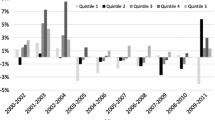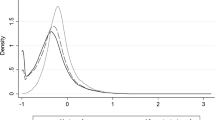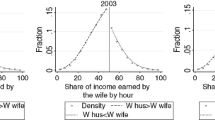Abstract
Up to 1987 the Spanish Income Tax imposed compulsory joint filing for married couples. However, the 1988 reform allowed spouses to choose between joint and separate taxation, involving a reduction in tax rates for secondary earners. Our aim is to analyze this reform as a quasi-natural experiment, assessing the effects of tax changes on labor participation. To find out the causal effect we adopt the difference-in-differences technique. We use data from the ‘Spanish Income Tax Panel 1982–1998’. Our results show that, as a consequence of differential tax changes, married women in families more strongly affected by the fiscal reform increase their labor participation more than secondary earners from families less affected by the reform. The participation rate for secondary earners in the treatment group increases by 9.4 percentage points whereas the control group increases their participation rate by 7.8 percentage points. We define the treatment group as those secondary earners in relatively low-income families in year 1987 and the control group as those in middle-high income families, because the former experiences a stronger reduction in tax rates than the latter. As a result, we can attribute the 1.6-percentage-point-increase in participation rates to the 1988 income tax reform.



Similar content being viewed by others
Notes
The peseta was the Spanish currency before the introduction of the euro. 1 euro equals 166.386 pesetas.
We are implicitly identifying the secondary earner as a woman. Data do not provide the gender variable, so we could not distinguish in which cases the secondary earner is a woman. Nevertheless, we think that for this period (1987–1991) in Spain the assumption is quite realistic. This assumption is not really needed for our paper, but it could help to understand how the tax reforms have contributed to increase the labor participation rate of married women.
Calculating tax rates, we have chosen the effective tax rates, that is, the result of dividing Net Tax by Tax Base. In order to calculate Net Tax, we considered all the tax credits related with tax unit: General Tax Credit, Married Couples Tax Credit, Variable Tax Credit/Joint Filing Tax Credit and Labor Income Tax Credit. Nevertheless, we did not consider other family tax credits that wouldn’t affect the choice between individual filing and joint filing: Child Tax Credit, Ancestors Tax Credit, Age Tax Credit and Handicapped Tax Credit.
Child Tax Credit and Ancestors Tax Credit consist on a fixed amount per child/ancestor. Taking into account these tax credits suppose to consider family size and composition.
As stated previously, we assume that the secondary earner is a woman.
These results take into account the tax rates and the labor participation of 1991, the last year of the panel. The results for the previous years 1989 and 1990 follow the same trend (0.5 and 0.8 percentage points).
References
Badenes, N. (2001). Cambios en el comportamiento de los segundos perceptores de renta tras la eliminación de la obligatoriedad del sistema de tributación conjunta. In N. Badenes (Ed.), IRPF, eficiencia y equidad: Tres ejercicios de microsimulación (pp. 13-74). Madrid: Instituto de Estudios Fiscales.
Becker, S., & Ichino, A. (2002). Estimation of average treatment effects based on propensity scores. The Stata Journal, 2(4), 358–377.
Blundell, R. (1992). Labour supply and taxation: A survey. Fiscal Studies, 13(3), 15–40.
Blundell, R. and MaCurdy, T. (1999). Labor supply: A review of alternative approaches. In O. Ashenfelter and D. Card (Eds.), Handbook of labor economics. Amsterdam: North-Holland.
Bosch, N., & van der Klaauw, B. (2012). Analyzing female labor supply—evidence from a Dutch tax reform. Labour Economics, 19(3), 271–280.
Caliendo, M., & Kopeinig, S. (2008). Some practical guidance for the implementation of Propensity Score Matching. Journal of Economic Surveys, 22(1), 31–72.
Callan, T., van Soest, A. H., & Walsh, J. R. (2009). Tax structure and female labour supply: Evidence from Ireland. Labour, 23(1), 1–35.
Card, D., & Krueger, A. (1994). Minimum wages and employment: A case study of the fast-food industry in New Jersey and Pennsylvania. American Economic Review, 84, 772–93.
Cook, T. D., & Campbell, D. T. (1979). Quasi-experimentation: Analysis issues for field settings. Boston: Houghton Mifflin Company.
Crossley, T. F., & Jeon, S. (2007). Joint taxation and the labour supply of married women: Evidence from the Canadian tax reform of 1988. Fiscal Studies, 28(3), 343–365.
Dehejia, R., & Wahba, S. (2002). Propensity score matching methods for nonexperminental causal studies. The Review of Economics and Statistics, 84(1), 151–61.
Díaz Mendoza, M. (2004). La respuesta de los contribuyentes ante las reformas del IRPF, 1987-1994. Tesina del CEMFI, no. 04059.
Eissa, N. (1995). Taxation and labor supply of married women: The Tax Reform Act of 1986 as a natural experiment. National Bureau of Economic Research (NBER), Working Paper 5023.
Eissa, N. and Hoynes, H. (2005). Behavioral responses to taxes: Lessons from the EITC and labor supply. National Bureau of Economic Research (NBER), Working Papers 11729.
Eissa, N., Kleven, H. J., & Kreiner, C. T. (2008). Evaluation of four tax reforms in the United States: Labor supply and welfare effects for single mothers. Journal of Public Economics, 92(3-4), 795–816.
Fan, C. (1988). Income tax policies and the labor supply of female secondary income earners. Public Finance, 43(1), 67–78.
Feldstein, M. (1995). The effect of marginal tax rates on taxable income: A panel study of the 1986 Tax Reform Act. Journal of Political Economy, 103(3), 551–572.
Gustafsson, S. (1992). Separate taxation and married women’s labor supply: A comparison of West Germany and Sweden. Journal of Population Economics, 5(1), 61–85.
Hanappi, T. P. & Müllbacher, S. (2013). Tax incentives and family labor supply in Austria. Review of Economics of the Household, 1–27.
Hausman, J. A. (1981). The effect of taxes on labor supply. In H. Aaron and J. Pechman (Eds.), How taxes affect economic behavior. Washington DC: Brookings.
Heckman, J. (1993). What has been learned about labor supply in the past twenty years? American Economic Review, 83(2), 116–121.
Heckman, J., Ichimura, H., & Todd, P. (1997). Matching as an econometric evaluation estimator: Evidence from evaluating a job training programme. The Review of Economic Studies, 64, 605–654.
Hotchkiss, J. L., Moore, R. E., & Rios-Avila, F. (2012). Assessing the welfare impact of tax reform: A case study of the 2001 U.S. tax cut. Review of Income and Wealth, 58(2), 233–256.
Kabátek, J., van Soest, A., & Stancanelli, E. (2014). Income taxation, labour supply and housework: A discrete choice model for French couples. Labour Economics, 27(April), 30–43.
Keane, M. P. (2010). Labour supply and taxes: A survey. University of Technology Sydney, Working Paper 160.
Kumar, A. (2016). Lifecycle-consistent female labor supply with nonlinear taxes: evidence from unobserved effects panel data models with censoring, selection and endogeneity. Review of Economics of the Household, 14(1), 207–229.
Kumar, A., & Liang, C. (2015). Declining female labor supply elasticities in the U.S. and implications for tax policy: Evidence from panel data. Federal Reserve Bank of Dallas, Working Papers 1501.
Lalumia, S. (2008). The effects of joint taxation of married couples on labor supply and non-wage income. Journal of Public Economics, 92(7), 1698–1719.
Leuthold, J. H. (1979). Taxes and the two-earner family: Impact on the work decision. Public Finance Quarterly, 7(2), 147–161.
MaCurdy, T., Green, D., & Paarsch, H. (1990). Assessing empirical approaches for analysing taxes and labor supply. Journal of Human Resources, 25(3), 415–490.
Meghir, C. and Phillips, D. (2008). Labour supply and taxes. Institute for Fiscal Studies (IFS), Working Paper 04/08.
Onrubia Fernández, J. & Sanz Sanz, J. F. (2009). La elasticidad de la renta gravable a los tipos marginales: Cálculos para España a partir de la rémora fiscal. Paper presented at the XVI Encuentro de Economía Pública, Granada.
Raute, A. (2016). Can financial incentives reduce the baby gap? Evidence from a reform in maternity leave benefits. Paper presented at CESifo Area Conference on Employment and Social Protection, Munich.
Rosenbaum, P., & Rubin, D. (1983). The central role of the Propensity Score in observational studies for causal effects. Biometrika, 70(1), 41–55.
Rosenbaum, P., & Rubin, D. (1984). Reducing bias in observational studies using subclassification on the propensity score. Journal of the American Statistical Association, 79, 516–24.
Rubin, D. D. (1974). Estimating causal effects of treatments in randomized and nonrandomized studies. Journal of Educational Psychology, 66(5), 688–701.
Sanmartín Sola, J. (2007). El efecto de los cambios en los tipos marginales sobre la base imponible del IRPF. Hacienda Pública Española, 182, 9–28.
Selin, H. (2014). The Rise in Female Employment and the Role of Tax Incentives. An Empirical Analysis of the Swedish Individual Tax Reform of 1971. International Tax and Public Finance, 21(5), 894–922.
Streiner, D., & Norman, G. (2012). The pros and cons of propensity scores. CHEST, 142, 1380–1382.
Tsounta, E. (2006). Why are women working so much more in Canada? An international perspective. International Monetary Fund (IMF), Working Paper 06/92.
Yamada, K. (2011). Labor supply responses to the 1990s Japanese tax reforms. Labour Economics, 18(4), 539–546.
Acknowledgments
We gratefully acknowledge the contributions of the seminar participants for their very helpful comments and suggestions at the IX Summer School in Public Economics, Georgia State University, Atlanta (2013), XXI Meeting of Public Economics, University of Girona, Spain (2014), and at a seminar given in our Department of Applied Economics at the University of Valencia (2014).
Author information
Authors and Affiliations
Corresponding author
Ethics declarations
Conflict of interest
The authors declare that they have no conflict of interest.
Rights and permissions
About this article
Cite this article
Fuenmayor, A., Granell, R. & Mediavilla, M. The effects of separate taxation on labor participation of married couples. An empirical analysis using propensity score. Rev Econ Household 16, 541–561 (2018). https://doi.org/10.1007/s11150-016-9345-x
Received:
Accepted:
Published:
Issue Date:
DOI: https://doi.org/10.1007/s11150-016-9345-x




